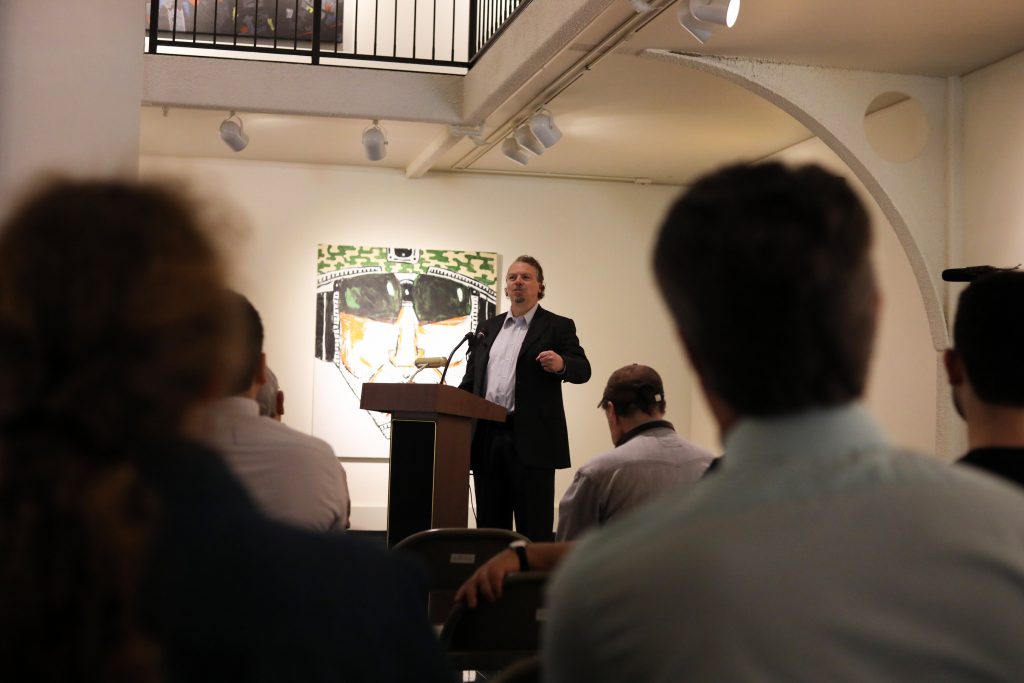
Students and faculty gathered in a room in the Fine Arts Building on Thursday to remember the Holocaust and its victims.
Binghamton University’s Institute for Genocide and Mass Atrocity Prevention (I-GMAP) sponsored the Holocaust Remembrance Day event, which brought academics to the University to discuss the history of the genocide. Steven Luckert, ‘93, former head curator of the permanent exhibition and current senior program curator in the Levine Institute for Holocaust Education at the United States Holocaust Memorial Museum in Washington, D.C., held a public talk titled “Holocaust and Genocide Museums in the 21st Century: Challenges and Opportunities.”
Nadia Rubaii, co-director of I-GMAP and a professor and chair of public administration at BU, said the practitioners in residence program, which aims to break down barriers and build bridges between academics and practitioners, were key to the purpose of Luckert’s presentation.
“This event is part of a series of events that the Institute for Genocide and Mass Atrocity Prevention has every year where we bring in ‘practitioners in residence,’ and those are individuals who work in any way, shape or form in government, nonprofit, civil society or the private sector to advance the goal of preventing genocide and mass atrocity,” Rubaii said. “Luckert contacted us, and once we learned about him and the kind of work that he did, we started planning, about a year ago, for him to be here.”
According to Rubaii, the focus of working together and bringing a combination of both historical and future-oriented perspectives was a theme for the institute and Luckert’s talk.
“[Luckert’s] work focuses on how do you use all of that information from a horrific time in our world history and use it to educate people for the future,” Rubaii said.
Luckert began his speech by discussing how his exposure to Holocaust studies began at BU and how a multidisciplinary approach on the topic provided a deeper analysis of the study. Luckert discussed the opening of the United States Holocaust Memorial Museum and said as worldwide interest in the Holocaust has increased, attendance has grown.
“Since opening in April 1993, more than 44 million visitors have come to the United States Holocaust Memorial Museum,” Luckert said. “Over 1 million people per year visit the state museum of Auschwitz-Birkenau.”
Highlighting problems that the museums face, Luckert provided photos of shoes from Holocaust victims and said they have disintegrated over time, destroying valuable artifacts.
“We are facing a lot of challenges as well, and one of these is preserving and collecting artifacts before they disappear,” Luckert said. “The passing of the survivor generation is very sad, because not only are they blatant witnesses of what happened, but they bring a wealth of knowledge.”
Luckert said the museum has seen changes in audience participation, particularly in regard to reading patterns and the introduction of modern technology.
“Over the course of time, the amount of time attendees have spent reading has changed, a decrease in the number of words used, the amount of time people spend reading the text has declined,” Luckert said. “Photographing has become a way for people to remember what they saw with technology and take those memories with them. People spend more time looking at images than they do reading text.”
Sarah Prentice, a first-year graduate student studying public administration and student affairs administration, said she found the talk educational.
“Steven spoke at our class last week, so I came to hear him talk and expand on the topic,” Prentice said. “His talk about how museums were changing and revitalizing was interesting, especially regarding people who were reading less at museums.”
The use of modern technology has given both museums and academics the opportunity to better understand and visualize the Holocaust’s history, according to Luckert. Providing a photo of a 3D model of Auschwitz, Luckert said the model was used as evidence to refute claims made by Nazis during their trial in 2016.
”They designed this 3D virtual model so they could place that person where they were and determine what they could have seen and what was going on at that camp,” Luckert said. “Looking at this technology, you can map out death marches and determine the geography of the Holocaust.”
According to Luckert, there are efforts being made to reach international audiences with Holocaust and genocide history education. In 2005, the museum partnered with Google Earth to highlight the genocide in Darfur, a region in western Sudan.
“The topic is important today — with hate speech and misinformation,” Luckert said. “You saw from these satellite photographs the kind of destruction that was taking place. All this becomes very important when using technology to elucidate the past by using things like a geographic information system to give you insights into what’s happening.”


